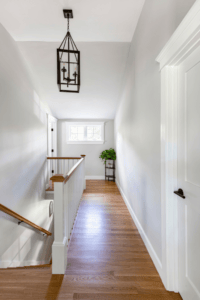25 May Renovate Today While Planning For The Future
When it comes to renovation, there arguably is no such thing as “done” when it comes to adapting your living space to meet your needs over time. Maybe you’re dealing with a long renovation list that you want to break up into more manageable projects, or perhaps you haven’t considered what those future needs might be.

Second Floor Includes Structural Updates for a Future First Floor Remodel
When you think of your life today, it is probably far different than it was even ten years ago. And, as our lives go through different phases, so too do our housing needs. When clients come to us, there is understandably a sense of urgency about the near-term changes they are looking for. But that initial project is rarely the end. For some homeowners, accomplishing their full renovation wish list in the near term may need to be tempered by practical considerations. Others may be more focused on their near-term needs. But, whatever their particular circumstances, what many don’t realize is that by taking a step back and looking at the long term, today’s renovation plans can pave the way for future renovation needs.
In fact, that is a key benefit of working with an end-to-end design-build firm. We have found that by keeping their longer-term vision in mind when planning that first stage we can consider any anticipated future renovation plans in our design, potentially saving them valuable time and resources when that next chapter comes.
At Lee Kimball, our first priority is to thoroughly understand our clients and their space, not just for the here and now, but for the future. These initial discussions are key to giving us both a short and long-term view of how the home can best function for its owners. This may include learning about our homeowners’ future renovation wish list, or by asking the right questions that help us uncover those future opportunities.
What are some examples of this? Take bathrooms. If renovating this space is on your list, considering your needs now and later can pay dividends. You may want a sleek shower design now, but by reinforcing the walls through a process called “blocking,” you’ll have the ability to add safety grab bars if you ever need them in the future, without having to remove and replace the shower wall again. In fact, incorporating an “aging in place” planning approach will help identify other opportunities for wall blocking or expanding doorways or hallways to provide ample space for a wheelchair if one is ever needed. Even if you do plan to sell the home at some point, positioning it for aging in place modifications will help your property appeal to more potential buyers.
Perhaps you want to keep the possibility of a future addition to accommodate parents or an aging child by considering where an access hallway could be created if needed, or position plumbing and electricity for a potential bathroom. Or you may be considering what it might take to repurpose a first-floor office as a primary bedroom suite or guest room.
And, if you’re tackling a larger renovation project through a phased approach, considering the implementation of any needed structural or mechanical elements for subsequent phases will help pave the way for those renovations, eliminating needless disruption and expense.
In one of our recent renovation projects focused on expanding and renovating the second floor of our client’s home, our early conversations revealed her desire was to eventually renovate the first floor, including a completely remodeled kitchen. That presented us with an opportunity to pave the way for those future remodeling projects. With her plans considered, we were able to incorporate structural elements into the build-out of the second floor that would allow for an easier, less costly, and more accessible eventual renovation of the first floor.
To do this, we considered future renovation needs such as layout, window placement, plumbing, and electrical configurations. By incorporating some of that work in the first phase, we helped the client avoid redoing that initial planning and foundational work. The result? Not only were we able to keep her budget in check, we ensured that her first floor renovation could proceed smoothly when the time was right.





